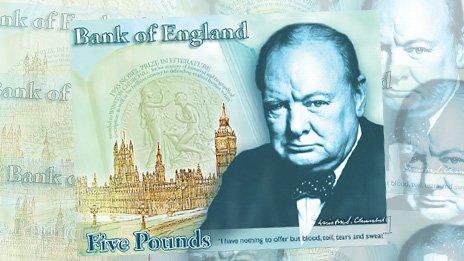Plastic banknotes to start in 2016, Bank of England says
- Published
- comments
The Bank of England's Executive Director for Banking Services, Chris Salmon: "The environmental impact of a polymer bank note is actually less than paper bank notes"
Plastic banknotes that can survive a spin in the washing machine are to be brought into circulation by the Bank of England in 2016.
The Bank argues that the polymer notes stay cleaner and are more secure than cotton paper notes, which have been used for more than 100 years.
The £5 note featuring Sir Winston Churchill will be the first plastic banknote.
More than 20 countries around the world have adopted polymer banknotes.
Public view
The Bank of England said in September that it was considering a switch from cotton paper to polymer notes.
It then visited various shopping centres around the UK to gauge public opinion about the proposed change.
Nearly 13,000 people gave feedback. The Bank said 87% of those who responded were in favour of polymer, only 6% were opposed and 7% were neutral. However, some suggested the notes were too slippery.

The £5 note featuring Winston Churchill will be the first plastic banknote
It has now confirmed their introduction into the currency, starting with the £5 note. The £10 note is to go plastic about a year later, carrying the image of Jane Austen.
The new banknotes will be made from a thin, transparent and flexible film made of polypropylene.
This is coated with an ink layer that enables it to carry the printed design features of a banknote. This allows the inclusion of windows or clear portions in the design, used to enhance protection against counterfeits.
The Bank has said that these notes last for 2.5 times longer than paper banknotes. They will survive a spin in the washing machine, but will still melt under extreme heat such as an iron.
The general public react to the prototype polymer Bank of England £10 note: "It looks fake"
Mark Carney, governor of the Bank of England, said: "Ensuring trust and confidence in money is at the heart of what central banks do.
"Polymer notes are the next step in the evolution of banknote design to meet that objective. The quality of polymer notes is higher, they are more secure from counterfeiting, and they can be produced at lower cost to the taxpayer and the environment."
Smaller notes
The Bank said it expected to enter a contract with Innovia Security to supply the polymer material for the new £5 and £10 notes, in which case Innovia would establish a polymer production plant in Wigton, Cumbria, in 2016.
The new notes will initially cost more to make but the extra durability of the notes means they will be cheaper to issue than paper notes, the Bank has argued.
They will have smaller dimensions than the current stock of notes.
Consequently a gradual introduction will allow cash machine operators to alter ATMs to be able to carry the new, smaller note.
It is not the first time plastic notes have been used in the UK.
In 1999, Northern Bank of Northern Ireland issued a polymer £5 commemorative note celebrating the year 2000.
A plastic note was introduced in the Isle of Man in 1983 but was withdrawn in 1988 owing to problems with the ink
Adopters of the notes include Canada, whose last central bank governor - Mark Carney - is now the governor of the Bank of England.
New choices
The Bank of England has been busy redesigning banknotes, following the announcement of Churchill's inclusion on the £5 note from 2016 at the earliest.
This created controversy over the potential lack of women on Bank of England notes, so in July the Bank said it planned to put Jane Austen on the next version of the £10 note.
Now, the Bank has outlined plans on how it will choose historical characters on banknotes.
A committee will choose a theme to be represented, such as a figure representing scientific achievement. A two-month nomination process will then include views from members of the public and experts in that field.
The committee will draw up a shortlist to hand to the Bank's governor for a final decision.
In light of the recent difficulties, the Bank said that no "unduly divisive" characters would be considered.
It will only consider historic characters. The only image of a living person carried on a banknote would be the monarch, it said.
- Published8 October 2013
- Published24 July 2013
- Published26 April 2013
- Published2 February 2013
- Published18 November 2011